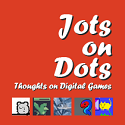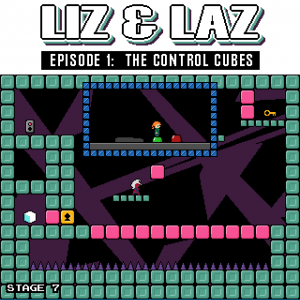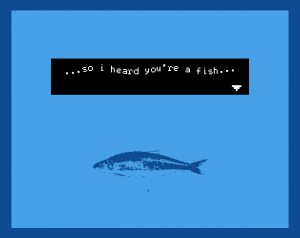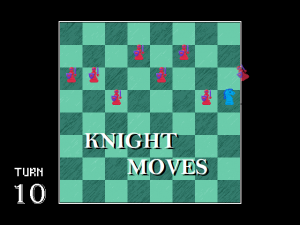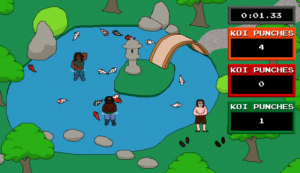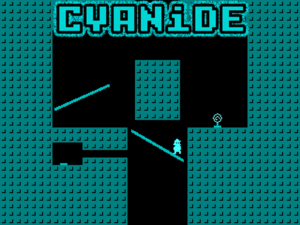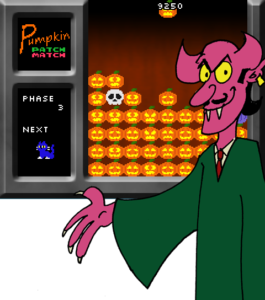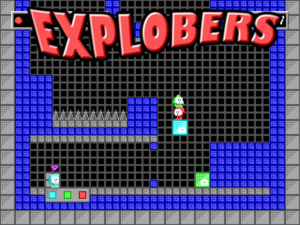~In which I celebrate a game-making milestone by indulging in some navel-gazing bullshit~
This website is now home to a full ninety (90) free games! The earliest game on the site dates back to September 1, 1997’s truly embarrassing ZZT game Bob: The Adventure and runs up to June 7, 2018’s Liz & Laz: Episode 1: The Control Cubes. This isn’t as interesting a number as 100 will be–I expect I’ll hit that some time next year–but if you’ll forgive me, dear reader, I’m gonna get all retrospective for a bit anyway.
 Relatedly, the release of my 90th game coincides roughly with the twenty-year anniversary of the launch of my first website, Newt’s Pond, which first went up on Geocities on June 10, 1998. It was a true Geocities site, and you can see a facsimile of what it looked like at launch archived at Neocities. The site would change over the years, but it was initially home to two webpages, ZZT Planet (a place to download my (Newt’s) games) and Moo@You, a page that advocated role-playing as an obnoxious cow in random chat rooms. Before the launch of Newt’s Pond, my handful of ZZT games had been released on my cousin Glynth’s site.
Relatedly, the release of my 90th game coincides roughly with the twenty-year anniversary of the launch of my first website, Newt’s Pond, which first went up on Geocities on June 10, 1998. It was a true Geocities site, and you can see a facsimile of what it looked like at launch archived at Neocities. The site would change over the years, but it was initially home to two webpages, ZZT Planet (a place to download my (Newt’s) games) and Moo@You, a page that advocated role-playing as an obnoxious cow in random chat rooms. Before the launch of Newt’s Pond, my handful of ZZT games had been released on my cousin Glynth’s site.
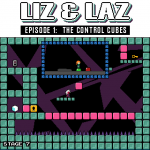 Liz & Laz is a fitting milestone for a personal game-making history that starts in ZZT. I was inspired to create it when revisiting some old ZZT “engine games,” particularly platformers. Engine games were ZZT worlds that used ZZT’s standard, uneditable four-direction player character to touch other objects that would manipulate a scripted player object. Playing some other vintage platformers led me back to thinking about some of my own. This dual player mechanic is actually pretty interesting!
Liz & Laz is a fitting milestone for a personal game-making history that starts in ZZT. I was inspired to create it when revisiting some old ZZT “engine games,” particularly platformers. Engine games were ZZT worlds that used ZZT’s standard, uneditable four-direction player character to touch other objects that would manipulate a scripted player object. Playing some other vintage platformers led me back to thinking about some of my own. This dual player mechanic is actually pretty interesting!
My first engine game was Punctuation People, made in the summer of 1998, a game that began its life as an attempt to make a Super Mario Bros. game in ZZT (all the game’s enemies are modeled on Mario enemies, a fact somewhat obscured by the ASCII character set). It was my first game that wasn’t a sloppy “comedy” adventure game. I was thinking of Punctuation People with its awkward occupation of a sizable portion of screen real estate. Like a lot of engine platformers, it surrounded the player on all sides with control objects. I was also thinking of my 1999 Lemmings clone Zem! 2 in which the player instead has indirect control over Zem, who marches forward mindlessly, but the player can have Zem perform actions by moving themselves along a row of buttons and touching them. The additional movement the main player object is required to perform impacts the rhythm of the game significantly.
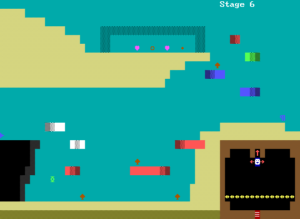
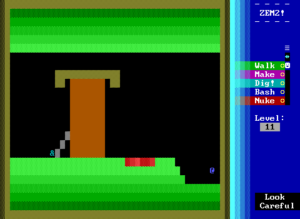
Liz & Laz started out from this observation about a ZZT genre as something intended as a kind of intentionally frustrating homage; I thought I’d make it a brief sketch of a game that I’d tinker with for a couple nights and then release half as a joke. I was surprised at how compelling I found the mechanic to play when testing it, though. Soon I was polishing up animations and fine-tuning level design (I was also inspired visually by the glorious platformer games by Kabusoft which I’m in the middle of writing up for my new review blog Jots on Dots). I reinterpreted the ZZT command objects to a human-sized gamepad and decided I’d make it a two-tiered platformer, in which Liz in the control console jumps on gamepad buttons to make her unseeing partner Laz walk, jump, and shoot.
I’m pretty happy with how it turned out and when I counted up how many games I had on the site, I was delighted that my 90th game had so many connections to places I’d been before.
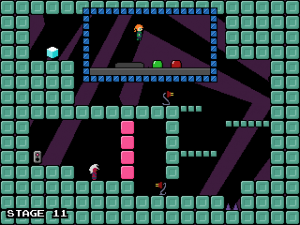
It is perhaps unsuprising that at this phase in my game-making I’m reflecting on my past work a lot. The 90 games housed here are spotty in quality and it’s sometimes a little weird to me that unfunny “comedy” games I made when I was 14 sit presented here with almost equal weight as games I’ve spent three months polishing. But I like that uncurated retrospective of my own work. And I’ve been taking surprising inspiration from it, as well as revisiting and rethinking the scenes I was a part of.
My output has been spotty, with long lulls. In 2012 alone, I released 38 games, including Caverns of Khron, which I worked on for 11 months–all while attending school full-time, working part-time, and relocating to Japan for a year of study abroad (I should note that 25 of these were made in the span of two weeks for Pirate Kart V)! This was a giddy period of experimentation and exploration, when I was getting good enough at Game Maker to make more complex games quickly, was standardizing and streamlining my bag of programming tricks, and was brimming with mechanical and aesthetic ideas I hadn’t tried yet, all drawing off the infectious creative energy at Glorious Trainwrecks. Between 2013 and 2015, I released no games for almost two full years, occupied by other interests, life events, and the beginning of grad school. Most importantly, making games didn’t sound all that fun for a little while.
My creative impulses ebb and flow. Since ending my game-making hiatus in the spring of 2015 with one of my personal favorites among my games, Shadow Wrangler (like Laz & Liz another Lemmings-inspired game that could be defined as “platforming by proxy”), I’ve been making a few games a year and tending toward larger, more polished projects. It’s harder for me to sit down and make a game in four hours like I used to six years ago; I’ve become increasingly interested in stronger game cohesion and narratives, accessible player experiences, and more careful, focused development in my practice.
I have some very exciting plans yet on the horizon in 2018, and some of it is going to involve revisiting unfinished projects and a return to old titles and ideas (a return to Zem! might even be on the table). At the same time, I’m really not sure where things go from here. Liz & Laz, like a lot of my games, started as a lark that spun into something else entirely (and a 1,000-word, self-obsessed ramble). I’m about to head deep into developing a game for the Wumpus Jam I’m hosting (please join!) and I only have a vague sense of what that’s going to look like. Thanks for playing!
(And thanks Alexis JAnson for STK!)
